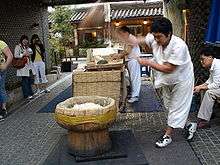List of Korean desserts

This is a list of Korean desserts. Korean cuisine known today has evolved through centuries of social and political change. Originating from ancient agricultural and nomadic traditions in southern Manchuria and the Korean peninsula, Korean cuisine has evolved through a complex interaction of the natural environment and different cultural trends.[1]
Korean desserts

- Gyeongju bread is a small pastry with a filling of red bean paste.

 Hotteok with edible seeds
Hotteok with edible seeds
Hangwa

Yeot covered with nuts (ttangkong yeot). Yeot is made from steamed rice, glutinous rice, glutinous sorghum, corn, sweet potatoes, or mixed grains. The steamed ingredients are lightly fermented and boiled in a large pot called a sot.
Hangwa is a general term for Korean traditional confectionery. Common ingredients in hangwa are grain flour, honey, yeot, sugar, fruit or edible root.
 Dasik, a variety of hangwa, is made from nongmal (which is starch made from potatoes, sweet potatoes or soaked mung beans), pine pollen singamchae, black sesame, honey, flour from rice or other grains, nuts and/or herbs.[2][3][4]
Dasik, a variety of hangwa, is made from nongmal (which is starch made from potatoes, sweet potatoes or soaked mung beans), pine pollen singamchae, black sesame, honey, flour from rice or other grains, nuts and/or herbs.[2][3][4]
Tteok

Tteok being pounded; hundreds of different kinds of tteok are eaten year round
See also: List of tteok varieties
Tteok is a class of Korean rice cakes made with glutinous rice flour (also known as sweet rice or chapssal), by steaming.
- Baekseolgi
- Baram tteok
- Bupyeon
- Danja
- Hwajeon
- Injeolmi
- Jeolpyeon
- Jeungpyeon
- Mujigae tteok
- Sirutteok
- Songpyeon
- Tteokbokki
- Tteokguk
- Yaksik
 Bupyeon, with mujigae tteok at top. Bupyeon are doughs of glutinous rice flour and a sweet filling and covered with gomul (powdered beans).[5]
Bupyeon, with mujigae tteok at top. Bupyeon are doughs of glutinous rice flour and a sweet filling and covered with gomul (powdered beans).[5] Jeolpyeon is prepared with rice powder dough which is steamed and patterned.
Jeolpyeon is prepared with rice powder dough which is steamed and patterned. Songpyeon are small rice cakes traditionally eaten during the Korean autumn harvest festival, Chuseok.
Songpyeon are small rice cakes traditionally eaten during the Korean autumn harvest festival, Chuseok.
See also
Korean desserts
Related topics
- Cuisine
- Korean snacks (category)
- List of desserts
- List of Korean beverages
References
- ↑ "Korean Cuisine (한국요리 韓國料理)" (in Korean). Naver / Doosan Encyclopedia. Retrieved 2009-03-28.
- ↑ "Kinds of Hangwa". Dasik (Pattern pressed cake). Korea Agro-Fisheries Trade Corporation. Retrieved 2008-06-02.
- ↑ "Dasik (다식 茶食)" (in Korean). EncyKorea. Retrieved 2008-06-02.
- ↑ Pyojun gugeo daesajeon: dasik
- ↑ 고물 (in Korean). Nate Korean-English Dictionary.
External links
-
 Media related to Desserts of Korea at Wikimedia Commons
Media related to Desserts of Korea at Wikimedia Commons -
 Media related to Hangwa at Wikimedia Commons
Media related to Hangwa at Wikimedia Commons -
 Media related to Tteok at Wikimedia Commons
Media related to Tteok at Wikimedia Commons
This article is issued from Wikipedia - version of the 3/26/2016. The text is available under the Creative Commons Attribution/Share Alike but additional terms may apply for the media files.

